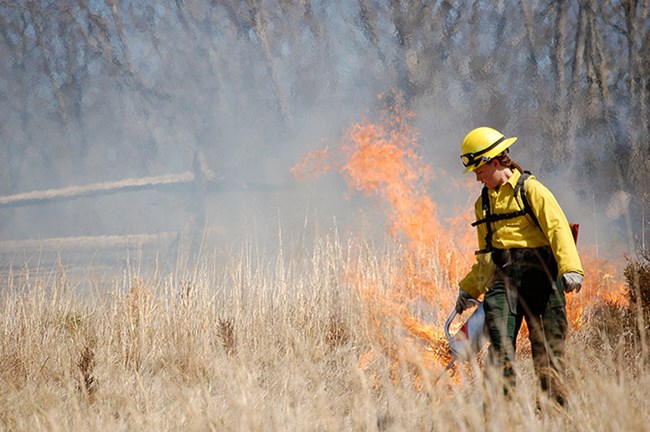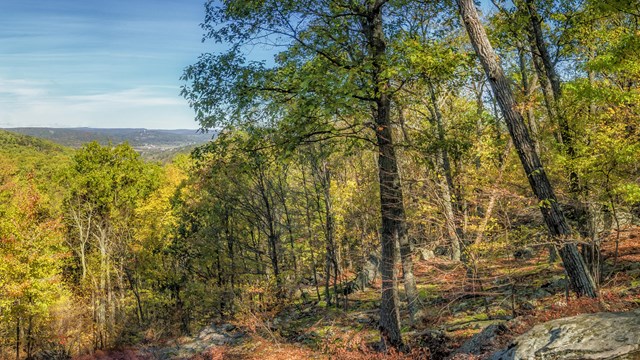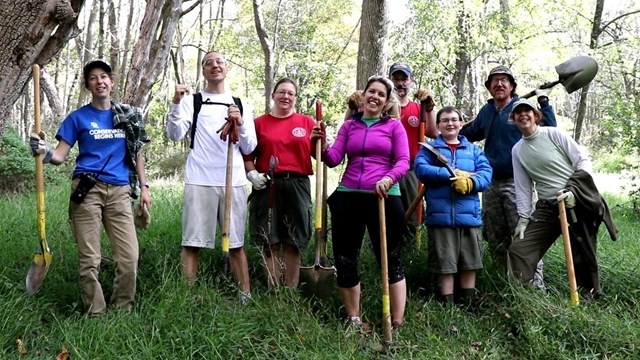
NPS Photo 
Centers for Disease Control Disease and Climate
Tick-borne Diseases
Lyme disease is the most common vector-borne disease (that is, a disease transmitted by mosquitoes, ticks, or fleas) in the United States. It is a bacterial illness spread by ticks that can cause fever, fatigue, joint pain, and skin rash, as well as more serious joint and nervous system complications. Warming winters are allowing more deer ticks to survive through to the spring. Because tick activity depends on temperatures being above a certain minimum, shorter winters could also extend the period when ticks are active each year, increasing the time that humans could be exposed to the disease. Take precautions to protect yourself from disease when hiking in tick habitat. Japanese Barberry and TicksInvasive Japanese barberry was introduced as an ornamental plant to the United States in 1875 and can be found throughout Catoctin Mountain Park. A hardy shrub, barberry is shade tolerant, drought resistant, and highly adaptable. Since introduction, it has spread across our backyards, forests, and fields, where it out-competes and takes space from native species. It’s harsh taste and spiny branches have left it untouched by browsing deer, further aiding its spread. It is perfect habitat for ticks. In areas where barberry is not contained, there can be 120 infected ticks per acre, vs only 10 infected ticks in an area where there is not barberry at all.

New York Department of Environmental Conservation Mosquito-borne DiseasesAs average temperatures and humidity increase, mosquitos are faring better in the region, increasing your risk of exposure to mosquito-borne illnesses. The mosquito season in Baltimore has grown faster than any other US city in recent decades. There, the invasive Asian tiger mosquito is now active for 152 days of the year, an increase of 37 days since 1980. First accidentally introduced into the US in 1985 on cargo from Asia, the mosquito is now found in 37 states and is known to spread Zika virus, west Nile virus, dengue, chikungunya, and yellow fever. 
NPS Photo WildfireDue to a longer growing season and increased risk of drought, the fire season has become longer and your risk of exposure is greater. Additionally, the spread of invasives increases fuel loads through the increase of biomass and mortality of native plants, while winter storms and wind events cause more downed woody debris. 
NPS Photo Bear EncountersAs winters warm, and become compressed, hibernation cycles are disrupted. Bears are going into hibernation later in the winter, and waking up earlier in the spring. This increases the risk for human-bear encounters. As the animals are more active throughout the year and changes in food availability force them to forage in closer proximity to human populations. Bears can grow larger due to the abundance of available food year round. Black bears prefer to avoid people, and rarely cause human injury. You may have even happened across one on the trail without even knowing it! A black bear will get away at the first sign of an approaching hiker, well before you notice it. Storing your food and disposing of garbage properly can mean life or death to a bear. Bears learn quickly and will return to areas where they find food. Not only can this be dangerous for people, but it is also harmful to bears that may need to be euthanized if they become too habituated to people and forage in campgrounds. Follow bear safe practices when traveling in bear country and camping in the park. 
Sustainability in the Park
From alternative fuels to energy saving appliances, the park is working towards a low carbon future. 
Eastern Forests and Climate
Changes in seasonal weather could have an impact on eastern forests, and the animals that call them home. 
How You Can Help
You can be a part of the solution. At home, on the road, and in the park – get involved! 
Climate Change
The greenhouse effect is becoming stronger due to human activity. ReferencesBrownstein, John S., Theodore R. Holford, and Durland Fish. “Effect of Climate Change on Lyme Disease Risk in North America.” EcoHealth 2.1 (2005): 38–46. PMC. |
Last updated: November 20, 2018
